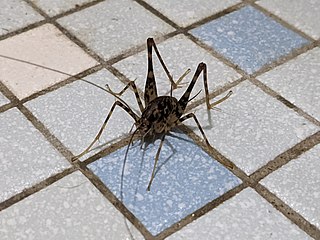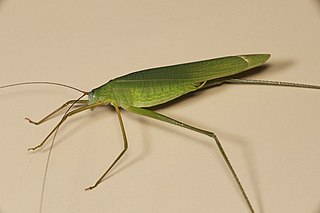
Anostostomatidae is a family of insects in the order Orthoptera, widely distributed in the southern hemisphere. It is named Mimnermidae or Henicidae in some taxonomies, and common names include king crickets in South Africa and wētā in New Zealand. Prominent members include the Parktown prawn of South Africa, and the giant wētā of New Zealand. The distribution of this family reflects a common ancestry before the fragmenting of Gondwana.

The orthopteran family Rhaphidophoridae of the suborder Ensifera has a worldwide distribution. Common names for these insects include the cave wētā, cave crickets, camelback crickets, camel crickets, spider crickets and sand treaders. Those occurring in New Zealand, Australia, and Tasmania are typically referred to as jumping or cave wētā. Most are found in forest environments or within caves, animal burrows, cellars, under stones, or in wood or similar environments. All species are flightless and nocturnal, usually with long antennae and legs. More than 1100 species of Rhaphidophoridae are described.

The Phaneropterinae, the sickle-bearing bush crickets or leaf katydids, are a subfamily of insects within the family Tettigoniidae. Nearly 2,060 species in 85 genera throughout the world are known. They are also known as false katydids or round-headed katydids.

Diestrammena is a 'camel' or 'cave-cricket' genus in the family Rhaphidophoridae. Species in the genus are native to Asia, including Japan.

Gryllacridinae is an Orthopteran subfamily in the family Gryllacrididae.

Larnaca is an Asian genus of Orthopterans, sometimes known as 'leaf-folding crickets', in the subfamily Gryllacridinae and tribe Gryllacridini. Species have been recorded from: southern China, Indochina and western Malesia.

Meconematinae is a subfamily of the bush crickets, with a worldwide distribution.

Mogoplistidae is a family of scaly crickets within the superfamily Grylloidea. Considered to be monophyletic, a sister taxon to the Gryllidae crickets. This family consists of 30 genera and 364 species worldwide; 20 species in 4 genera occur in North America and this family includes the scaly crickets of Europe.

Conocephalinae, meaning "conical head", is an Orthopteran subfamily in the family Tettigoniidae.

Trigonidium is a large genus of sword-tail crickets, typical of the tribe Trigonidiini. Records of occurrence are from Europe, Africa, tropical Asia, Australia and the Pacific islands; many species endemic to Pacific islands including Hawaii have now been placed in the genus Nudilla.
Lipotactes is a genus of bush cricket found in southern China, Indo-China and Malesia.

Elimaea is a large genus within Tettigoniidae, the bush cricket or katydid family. Species in this genus are found in India, southern China, Indo-China and Malesia.
Orthelimaea is a genus of Asian bush crickets in the tribe Elimaeini within the subfamily Phaneropterinae. Species in this genus are found in India, Indo-China, and Malesia.
The subfamily Rhaphidophorinae contains the single tribe of camel crickets, the Rhaphidophorini, based on the type genus Rhaphidophora.
Stonychophora is a genus of camel crickets in the tribe Rhaphidophorini. Species in this genus can be found from Indo-China and Malesia to New Caledonia.

Tachycines is a genus of camel crickets in the subfamily Aemodogryllinae and tribe Aemodogryllini. Some authorities had placed the type species, T. asynamorus, in the genus Diestrammena, but recent papers returned this to the subgenus Tachycines (Tachycines), with a substantial number of new species recently described.

Gryllacris is a genus of Orthopterans, sometimes known as 'leaf-folding crickets' in the family Gryllacridinae. It is the type genus for the family, tribe Gryllacridini and its subfamily.
Phryganogryllacris is an Asian genus of Orthopterans, sometimes known as 'leaf-folding crickets', in the subfamily Gryllacridinae and tribe Phryganogryllacridini. Species have been recorded from: India, China, Indochina, Malesia, through to New Guinea.
Neanias is a genus of Orthopterans, sometimes known as 'leaf-folding crickets' in the subfamily Gryllacridinae and tribe Gryllacridini. The recorded distribution is: Indian subcontinent, Japan, Hainan, Indochina, and western Malesia (Sumatra).

Diaphanogryllacris is a genus of Orthopterans, sometimes known as 'leaf-folding crickets' in the subfamily Hyperbaeninae and tribe Capnogryllacridini. The recorded distribution is: the Indian subcontinent, China, Indochina, western Malesia up to Sulawesi.












